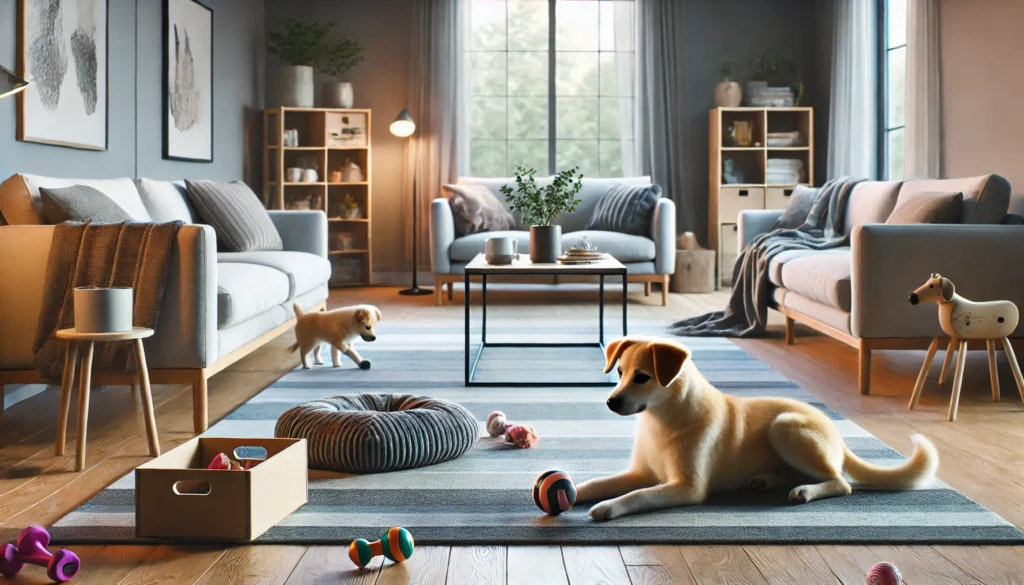Dogs are creatures of habit. They thrive in predictable environments where they know where to eat, sleep, play, and relax. So when you decide to rearrange the living room or redecorate your home, your dog might not take it as lightly as you do.
While a new sofa position may seem like a small change, for some dogs it can cause confusion, stress, or even behavioral regressions. Here’s how to move furniture around without making your dog anxious.
Why Dogs React to Environmental Changes
Dogs use more than just sight to understand their world. Their environment is made up of:
- Familiar scents
- Established pathways
- Predictable routines
- Known sleeping and feeding zones
When furniture is suddenly moved, they may:
- Lose their favorite nap spot
- Smell unfamiliar scents in new places
- Get startled by items in unusual positions
- Feel uncertain about where to go or rest
Sensitive, elderly, or anxious dogs are especially vulnerable to these disruptions.
Common Signs of Stress After Rearranging Furniture
Your dog may not be able to tell you they’re stressed — but their behavior might.
Look for signs such as:
- Pacing or restlessness
- Whining or barking without obvious triggers
- Hiding under furniture or in unusual places
- Avoiding certain rooms or areas
- Accidents in the house
- Excessive licking or chewing
If these behaviors emerge after changes in your home layout, it’s time to take supportive steps.
Plan Changes in Small Stages
If you can, don’t rearrange everything at once.
- Move one or two large pieces per day
- Let your dog observe the process from a safe space
- Reintroduce them to the new setup slowly
Gradual changes feel less chaotic and give your dog time to adjust mentally.
Let Your Dog Explore the New Layout
Once changes are made:
- Walk your dog through the updated space calmly
- Encourage sniffing and exploration
- Use treats and praise to associate positivity with the new setup
Let them rediscover the space in their own way, at their own pace.
Keep Familiar Items in Familiar Places
Provide stability by keeping some things consistent.
- Place your dog’s bed, toys, and food bowls in their usual locations if possible
- If moving them is necessary, relocate gradually and consistently
- Bring items with your scent to ease the transition
These anchors help your dog feel safe, even in a rearranged environment.
Use Scent to Reassure
Scent is powerful for dogs and can help reduce anxiety.
- Rub your hands or use a worn T-shirt to apply familiar scent to new furniture
- Use a calming dog pheromone diffuser or spray near rest areas
- Avoid strong air fresheners or cleaning products right after moving items
This helps re-mark the space with comfort and safety cues.
Maintain Routine Despite the Change
Even if your living room layout is new, keep your dog’s daily schedule the same.
- Stick to consistent feeding, walk, and play times
- Use familiar verbal cues (“bedtime,” “walk,” “good job”)
- Avoid introducing other major changes at the same time (like new people or pets)
Routines offer emotional grounding when the physical space shifts.
Encourage Calm With Positive Reinforcement
Use reassurance and rewards to help your dog adapt:
- Praise calm behavior when they approach new areas
- Give treats when they lie down or relax in a moved spot
- Avoid scolding nervous behavior — redirect with a toy or command
Focus on encouraging confidence, not punishing uncertainty.
Provide a Safe Retreat Zone
Every dog needs a place where nothing changes.
- Keep one room or corner as their “safe zone” during the rearrangement
- Don’t move their crate, blanket, or favorite bed until they’ve adjusted
- Allow them to retreat here freely if they feel overwhelmed
This gives them control in an environment that’s otherwise shifting.
Watch for Lingering Stress
Most dogs adjust within a few days, but some may take longer.
- If your dog avoids certain areas for more than a week, reintroduce slowly
- Use play, scent, and positive interactions in those spaces
- If stress behaviors continue, consult a vet or behaviorist
It’s better to catch emotional discomfort early than let it escalate.
Change Can Be Positive With the Right Support
Change is part of life — but for dogs, how we introduce it makes all the difference. By taking your time, maintaining routine, and offering gentle encouragement, you can make even the biggest room flip feel like no big deal to your pup.
After all, your dog doesn’t care where the couch is — as long as you’re sitting on it with them.






